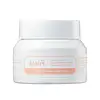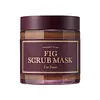What's inside
What's inside
 Key Ingredients
Key Ingredients

 Benefits
Benefits

 Concerns
Concerns

 Ingredients Side-by-side
Ingredients Side-by-side

Glycerin
HumectantSucrose
HumectantCetyl Ethylhexanoate
EmollientButyrospermum Parkii Butter
Skin ConditioningCaprylic/Capric Triglyceride
MaskingCetyl Alcohol
EmollientGlucose
HumectantCitrus Paradisi Fruit Extract
Skin ConditioningMicrocrystalline Wax
Emulsion StabilisingGlyceryl Stearate
EmollientSorbitan Stearate
EmulsifyingOlea Europaea Fruit Oil
MaskingSorbitan Sesquioleate
EmulsifyingPEG-100 Stearate
Simmondsia Chinensis Seed Oil
EmollientCellulose
AbsorbentCalamine
AbsorbentTocopheryl Acetate
AntioxidantRubus Idaeus Seed Oil
EmollientKaolin
AbrasiveQuartz
Abrasive1,2-Hexanediol
Skin ConditioningBisabolol
MaskingCitrus Grandis Peel Oil
MaskingButylene Glycol
HumectantLimonene
PerfumingGlycerin, Sucrose, Cetyl Ethylhexanoate, Butyrospermum Parkii Butter, Caprylic/Capric Triglyceride, Cetyl Alcohol, Glucose, Citrus Paradisi Fruit Extract, Microcrystalline Wax, Glyceryl Stearate, Sorbitan Stearate, Olea Europaea Fruit Oil, Sorbitan Sesquioleate, PEG-100 Stearate, Simmondsia Chinensis Seed Oil, Cellulose, Calamine, Tocopheryl Acetate, Rubus Idaeus Seed Oil, Kaolin, Quartz, 1,2-Hexanediol, Bisabolol, Citrus Grandis Peel Oil, Butylene Glycol, Limonene
 Reviews
Reviews

Ingredients Explained
These ingredients are found in both products.
Ingredients higher up in an ingredient list are typically present in a larger amount.
This ingredient is an emollient, solvent, and texture enhancer. It is considered a skin-softener by helping the skin prevent moisture loss.
It helps thicken a product's formula and makes it easier to spread by dissolving clumping compounds.
Caprylic Triglyceride is made by combining glycerin with coconut oil, forming a clear liquid.
While there is an assumption Caprylic Triglyceride can clog pores due to it being derived from coconut oil, there is no research supporting this.
Learn more about Caprylic/Capric TriglycerideSucrose is a natural sugar found in fruits, vegetables, and nuts. It is the main constituent of white sugar.
In skincare, sucrose is a humectant and can be a mild exfoliant.
Sucrose is hydrophilic, meaning it attracts water. This makes it an effective humectant and helps hydrate the skin.
Studies show sugars may worsen acne-prone skin due to it disrupting the skin's natural biome. We recommend speaking with a professional if you have any concerns.
In some products such as body scrubs, sucrose is used as an gentle exfoliant.
The term 'sucrose' comes from the french word for sugar, 'sucre'.
Learn more about Sucrose